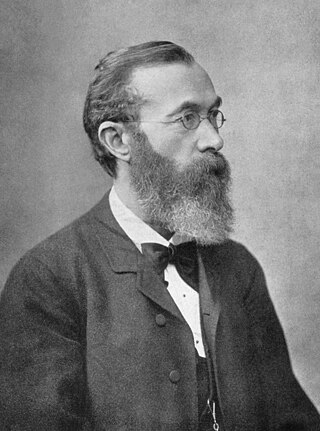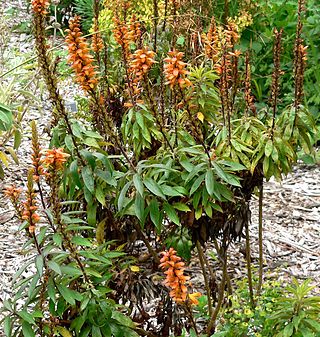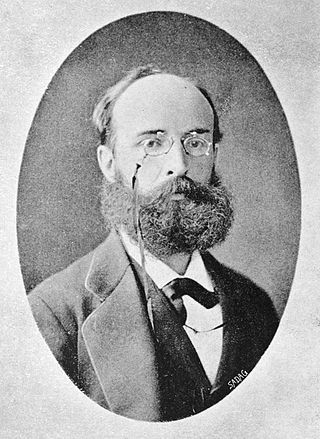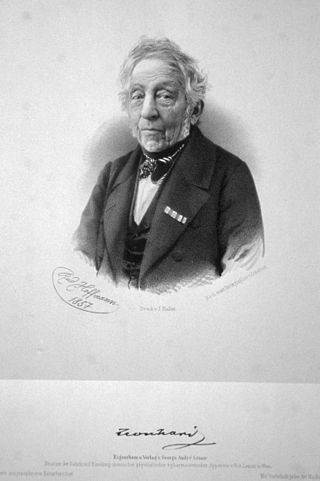
Wilhelm Maximilian Wundt was a German physiologist, philosopher, and professor, known today as one of the fathers of modern psychology. Wundt, who distinguished psychology as a science from philosophy and biology, was the first person ever to call himself a psychologist.

Christian Gottfried Ehrenberg was a German naturalist, zoologist, comparative anatomist, geologist, and microscopist. Ehrenberg was an evangelist and was considered to be one of the most famous and productive scientists of his time.

Heinrich Georg Bronn was a German geologist and paleontologist. He was the first to translate Charles Darwin's On the Origin of Species into German in 1860, although not without introducing his own interpretations, as also a chapter critiquing the work.

Alfred Lothar Wegener was a German climatologist, geologist, geophysicist, meteorologist, and polar researcher.

Eduard von Martens also known as Carl or Karl Eduard von Martens, was a German zoologist.

Isoplexis is a section of four species of flowering plants within the genus Digitalis in the plantain family Plantaginaceae. The species of section Isoplexis differ from other plants in the genus Digitalis in that their monosymmetric flowers have a distinctive large upper lip rather than large lower lip and the species are endemic to the Canary Islands and Madeira.

Wilhelm Reiss was a German geologist and explorer born in Mannheim. Along with Angel Escobar, he was the first person to scale Cotopaxi (1872), and with vulcanologist Alphons Stübel, he was the first to ascend Tungurahua (1873).

Karl Richard Lepsius was a pioneering Prussian Egyptologist, linguist and modern archaeologist.

Ernst Christian Julius Schering was a German mathematician.

Hermann Fol was a Swiss zoologist and the father of modern cytology.

Eberhard Fraas was a German scientist, geologist and paleontologist. He worked as a curator at the Stuttgarter Naturaliensammlung and discovered the dinosaurs of the Tendaguru formation in then German East Africa. The dinosaur Efraasia is named after him.

Robert Wilhelm Eberhard Bunsen was a German chemist. He investigated emission spectra of heated elements, and discovered caesium and rubidium with the physicist Gustav Kirchhoff. The Bunsen–Kirchhoff Award for spectroscopy is named after Bunsen and Kirchhoff.
Karl Wilhelm Georg von Fritsch was a German geologist and paleontologist.

The Friedenspark is an open space of about 20 hectares in the centre of Leipzig, in the district of Zentrum-Südost, located between the Ostplatz to the north and the Russian Memorial Church to the south. The park was opened in 1983, after the secularisation and clearance, under the then East German regime, of the Neuer Johannisfriedhof, which is what the space used to be, and its thorough reconstruction.
Heinrich Friedrich Franz Körte was a German natural and agricultural scientist, and for thirty years Professor of Natural Sciences at the Agricultural Academy in Möglin, which was founded by Albrecht Daniel Thaer.
Adolph von Morlot was a scientist who specialized in geology and later in archaeology. He was born in Naples, Italy and died in Bern, Switzerland. Von Morlot is known for performing the first ever high-temperature synthesis of the mineral dolomite and known by archaeologists as one of the pioneers of underwater archaeology. He was elected as a member to the American Philosophical Society in 1864.
Gustav Alfred Senn was a Swiss botanist and historian of botany. He was a student of Georg Klebs and worked on the movement and morphological changes of chloroplasts. He also studied Theophrastus.

Karl Cäsar von Leonhard was a German mineralogist and geologist. His son, Gustav von Leonhard, was also a mineralogist.

Adolph Kohut was a German-Hungarian journalist, literature and cultural historian, biographer, recitator and translator from Hungarian origin.

Dietmar Schneider is a German internist, neurologist and an extra-curricular professor for neurological intensive care medicine, 1997 at the University of Leipzig Medical Center.














